Plextor M5 Pro (256GB) Review
by Kristian Vättö on August 31, 2012 11:32 AM ESTAnandTech Storage Bench 2011
Last year we introduced our AnandTech Storage Bench, a suite of benchmarks that took traces of real OS/application usage and played them back in a repeatable manner. Anand assembled the traces out of frustration with the majority of what we have today in terms of SSD benchmarks.
Although the AnandTech Storage Bench tests did a good job of characterizing SSD performance, they weren't stressful enough. All of the tests performed less than 10GB of reads/writes and typically involved only 4GB of writes specifically. That's not even enough exceed the spare area on most SSDs. Most canned SSD benchmarks don't even come close to writing a single gigabyte of data, but that doesn't mean that simply writing 4GB is acceptable.
Originally we kept the benchmarks short enough that they wouldn't be a burden to run (~30 minutes) but long enough that they were representative of what a power user might do with their system. Later, however, we created what we refer to as the Mother of All SSD Benchmarks (MOASB). Rather than only writing 4GB of data to the drive, this benchmark writes 106.32GB. This represents the load you'd put on a drive after nearly two weeks of constant usage. And it takes a long time to run.
1) The MOASB, officially called AnandTech Storage Bench 2011—Heavy Workload, mainly focuses on the times when your I/O activity is the highest. There is a lot of downloading and application installing that happens during the course of this test. Our thinking was that it's during application installs, file copies, downloading, and multitasking with all of this that you can really notice performance differences between drives.
2) We tried to cover as many bases as possible with the software incorporated into this test. There's a lot of photo editing in Photoshop, HTML editing in Dreamweaver, web browsing, game playing/level loading (Starcraft II and WoW are both a part of the test), as well as general use stuff (application installing, virus scanning). We included a large amount of email downloading, document creation, and editing as well. To top it all off we even use Visual Studio 2008 to build Chromium during the test.
The test has 2,168,893 read operations and 1,783,447 write operations. The IO breakdown is as follows:
| AnandTech Storage Bench 2011—Heavy Workload IO Breakdown | ||||
| IO Size | % of Total | |||
| 4KB | 28% | |||
| 16KB | 10% | |||
| 32KB | 10% | |||
| 64KB | 4% | |||
Only 42% of all operations are sequential; the rest ranges from pseudo to fully random (with most falling in the pseudo-random category). Average queue depth is 4.625 IOs, with 59% of operations taking place in an IO queue of 1.
Many of you have asked for a better way to really characterize performance. Simply looking at IOPS doesn't really say much. As a result we're going to be presenting Storage Bench 2011 data in a slightly different way. We'll have performance represented as Average MB/s, with higher numbers being better. At the same time we'll be reporting how long the SSD was busy while running this test. These disk busy graphs will show you exactly how much time was shaved off by using a faster drive vs. a slower one during the course of this test. Finally, we will also break out performance into reads, writes, and combined. The reason we do this is to help balance out the fact that this test is unusually write intensive, which can often hide the benefits of a drive with good read performance.
There's also a new light workload for 2011. This is a far more reasonable, typical every day use case benchmark. It has lots of web browsing, photo editing (but with a greater focus on photo consumption), video playback, as well as some application installs and gaming. This test isn't nearly as write intensive as the MOASB but it's still multiple times more write intensive than what we were running last year.
We don't believe that these two benchmarks alone are enough to characterize the performance of a drive, but hopefully along with the rest of our tests they will help provide a better idea. The testbed for Storage Bench 2011 has changed as well. We're now using a Sandy Bridge platform with full 6Gbps support for these tests.
AnandTech Storage Bench 2011—Heavy Workload
We'll start out by looking at average data rate throughout our new heavy workload test:

Surprisingly, the M5 Pro is slightly slower than the M3 Pro in our Heavy suite. In all of our synthetic benchmarks, the M5 Pro was faster and in some cases by far.
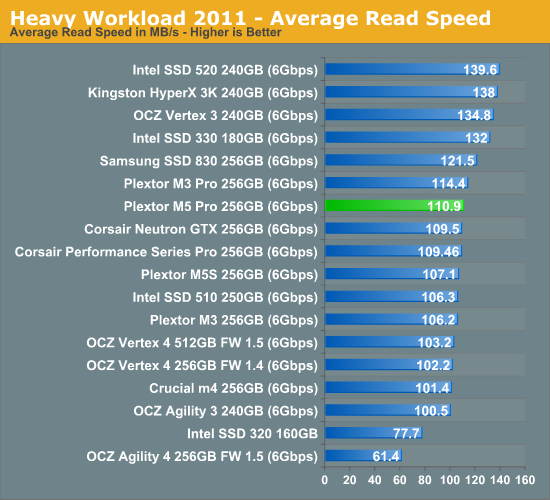
Read speed is where the M5 Pro is slower than the M3 Pro. While the difference is only 3.5MB/s, it's enough to make the average data rate smaller since our Heavy suite has more read operations. Write speed, on the other hand, is faster.
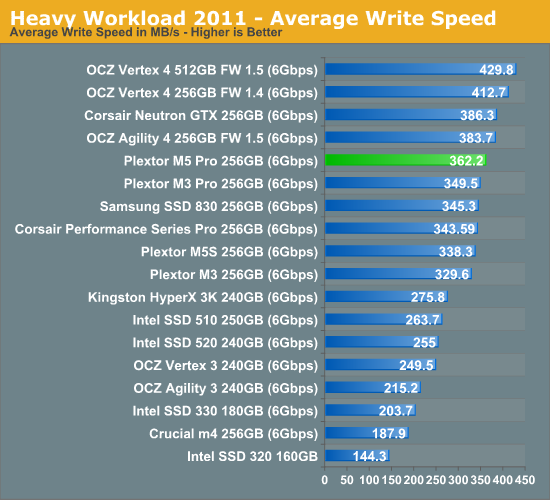
The next three charts just represent the same data, but in a different manner. Instead of looking at average data rate, we're looking at how long the disk was busy for during this entire test. Note that disk busy time excludes any and all idles; this is just how long the SSD was busy doing something:
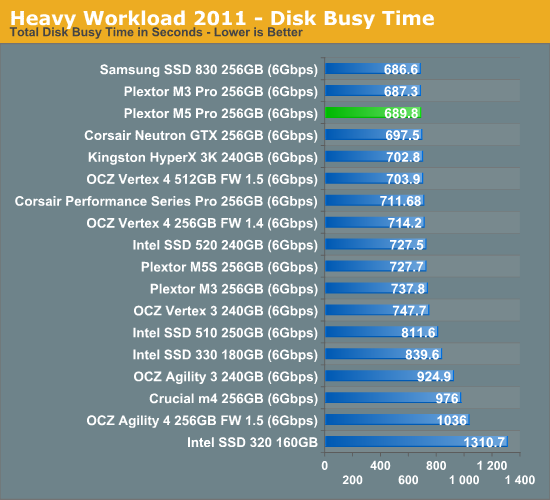
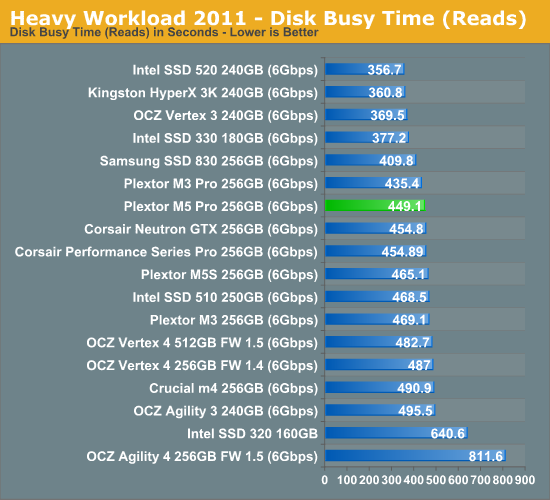
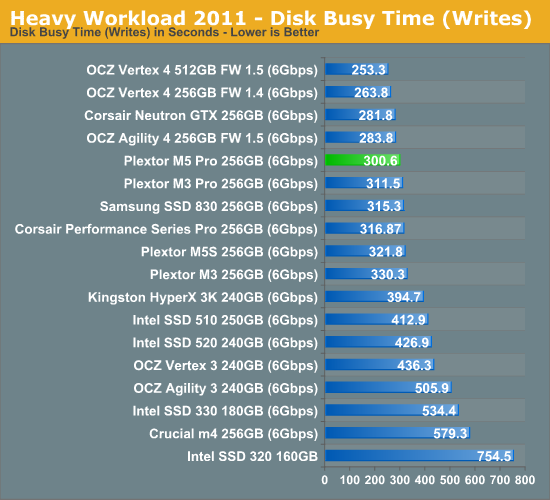










37 Comments
View All Comments
TemjinGold - Friday, August 31, 2012 - link
Was looking forward to this drive beating the Vertex 4 but not only does it not do that, it also costs a ridiculous amount...scottwilkins - Friday, August 31, 2012 - link
I'd call it a win if Plextor does better with less DOA units and better customer support. Every OCZ I've bought has required a firmware update, which are hard to do at best to start with. And I've just had too many OCZ failed drives. Sometimes second place is better, and in this case it might very well be so.LB-ID - Friday, August 31, 2012 - link
Amen to that, brother. OCZ drives are released in an alpha/beta state, and their support is simply atrocious. I'd far rather pay a little more and deal with a reputable company than go through the nightmare that is 'working' with OCZ.heffeque - Friday, August 31, 2012 - link
Plextor, unlike OCZ, does have a 5 year warranty...extide - Saturday, September 1, 2012 - link
actually, all Vertex 4's have 5 year warranty tooTemjinGold - Friday, August 31, 2012 - link
I would agree if they were close to the same price. Plextor is better but not for nearly 2x the price.hansmuff - Friday, August 31, 2012 - link
Kind of depends on how much your time is worth. If you have a lot of downtime due to the SSD crapping out, the Plextor might be well worth it.CeriseCogburn - Friday, August 31, 2012 - link
That's another reason why nVidia wins over amd gpu's.iamezza - Saturday, September 1, 2012 - link
piss off trollstalker27 - Tuesday, September 4, 2012 - link
:) ... he probably didn't get that "piss off troll" translates to "over the past years several large EU retailers have released reliability reports and AMD, in the graphics department, did some of the most reliable cards, Nv... not so much. Cudos to AMD's partners! RIP BFG!